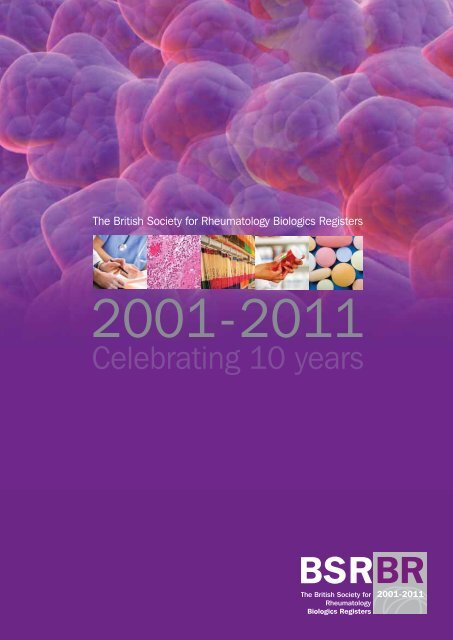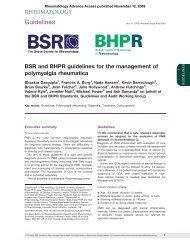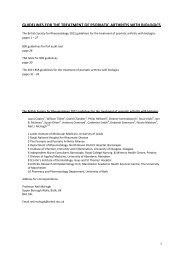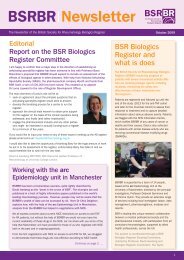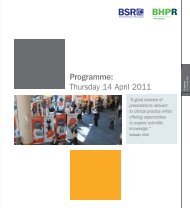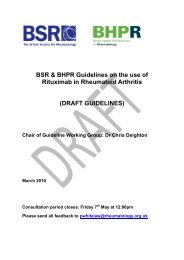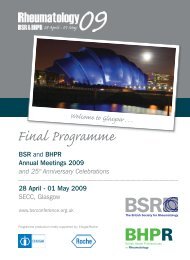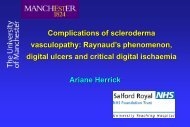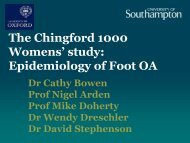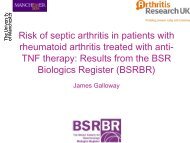BSRBR 10th Anniversary brochure - The British Society for ...
BSRBR 10th Anniversary brochure - The British Society for ...
BSRBR 10th Anniversary brochure - The British Society for ...
You also want an ePaper? Increase the reach of your titles
YUMPU automatically turns print PDFs into web optimized ePapers that Google loves.
<strong>The</strong> <strong>British</strong> <strong>Society</strong> <strong>for</strong> Rheumatology Biologics Registers<br />
2001-2011<br />
Celebrating 10 years
<strong>BSRBR</strong>: a cause <strong>for</strong> celebration<br />
In 2001 BSR launched the Biologics Register to monitor the safety and efficacy of a new<br />
generation of therapies <strong>for</strong> rheumatic diseases. Thanks to the collective endeavours of<br />
rheumatologists and allied health professionals across the country, it has become a research<br />
model respected worldwide. To mark its first decade, this report celebrates its achievements<br />
and continuing importance <strong>for</strong> the future.<br />
Professor David Isenberg, chair of the <strong>BSRBR</strong> Steering Committee from<br />
2006 to 2011, discusses the virtues of the Register as a model <strong>for</strong> others.<br />
2 | <strong>BSRBR</strong> 2001-2011<br />
To me, the Biologics Register is the jewel in<br />
the BSR’s crown, a wonderful creation that<br />
led the way nationally and showed the<br />
<strong>Society</strong> and its members were ahead of<br />
the game.<br />
One reason BSR started the Register was to<br />
make sure everything was above board<br />
when it came to studying the effects of<br />
these exciting new biologic agents. When<br />
corticosteroids were introduced in the late<br />
1940s, <strong>for</strong> example, it wasn’t unknown <strong>for</strong><br />
those with a vested interest to phone up<br />
the editors of journals who had published<br />
articles detailing their side-effects and<br />
harangue them <strong>for</strong> damaging the new<br />
drugs’ reputation.<br />
BSR and its Executive Committee wanted<br />
to get it right on drug safety and Professor<br />
Gabriel Panayi, the <strong>Society</strong>’s President at<br />
the time, deserves great credit <strong>for</strong> driving<br />
us on to create the Register.<br />
With almost 20,000 patients enrolled, it is<br />
now the world’s largest biologics registers, a<br />
model <strong>for</strong> others to follow. That in itself is a<br />
cause <strong>for</strong> celebration. Importantly, the way it<br />
is set up has the full approval of the National<br />
Institute <strong>for</strong> Health and Clinical Excellence<br />
(NICE), because of the benefits it brings to<br />
all parties involved.<br />
Pharmaceutical companies pay <strong>for</strong> the<br />
running of <strong>BSRBR</strong> and in return receive<br />
relatively cheap, long-term follow-up data on<br />
the drugs they produce. BSR enjoys the<br />
kudos <strong>for</strong> the work it has done in<br />
establishing and overseeing the Register.<br />
<strong>The</strong> Arthritis Research UK Epidemiology Unit<br />
at the University of Manchester has the<br />
pleasure of publishing many articles in<br />
learned journals based on researching<br />
data collected by the Register.<br />
A glass wall separates the parties involved.<br />
Drug companies pay BSR to run the Register<br />
rather than funding it directly. Researchers in<br />
Manchester, <strong>for</strong> their part, submit their<br />
papers <strong>for</strong> comment to the drug companies<br />
and the <strong>BSRBR</strong> Steering Committee be<strong>for</strong>e<br />
sending them to journals <strong>for</strong> publication.<br />
Any issues raised are then fed back to the<br />
committee. It passes on genuine concerns<br />
<strong>for</strong> Manchester to answer. This process<br />
allows everyone to have their say and<br />
completes the audit loop.<br />
<strong>The</strong> Register has evolved a great deal over<br />
the past 10 years and a new register <strong>for</strong><br />
ankylosing spondylitis is about to start<br />
recruiting patients. What has been most<br />
gratifying <strong>for</strong> me is that BSR has been seen<br />
to be going places and has set a standard<br />
of excellence that is recognised worldwide.<br />
When I am at conferences abroad, it is not<br />
uncommon <strong>for</strong> delegates to come up and<br />
tell me that we have got it right.<br />
Clinical trials give an indication of whether<br />
a new drug will be beneficial, but their<br />
samples are usually small and to a degree<br />
self-selecting. Often they don’t take into<br />
account a patient’s full medical history.<br />
<strong>BSRBR</strong>, though, tells you what is going on<br />
in real life where patients have RA but may<br />
also have other conditions too.<br />
That makes <strong>BSRBR</strong> a more powerful<br />
instrument <strong>for</strong> researchers than clinical<br />
trials. It has allowed us both to identify<br />
unexpected benefits of anti-TNA drugs<br />
and to allay fears about these drugs.<br />
<strong>The</strong> Register has also identified the<br />
unexpected such as the small number of<br />
patients who have developed psoriasis as<br />
a result of their treatment.
Professor Alex MacGregor, current chair of the <strong>BSRBR</strong> Steering<br />
Committee, outlines future plans <strong>for</strong> the Register.<br />
<strong>BSRBR</strong> was one of the first registers<br />
monitoring the treatment of rheumatoid<br />
arthritis with biologics. Now it sits in a<br />
constellation of similar studies in Europe<br />
and around the world and has inspired the<br />
creation of registers <strong>for</strong> other rheumatic<br />
diseases. Such long-term studies contribute<br />
greatly to our understanding of these<br />
conditions and their treatment.<br />
Monitoring the long-term safety of patients<br />
remains an essential part of <strong>BSRBR</strong>’s work.<br />
Now, though, we are entering an age where<br />
per<strong>for</strong>mance is assessed and resources<br />
squeezed, especially in relation to the use of<br />
expensive drugs. That makes capturing the<br />
outcomes of treatments of increasing value<br />
to our profession.<br />
My role is strategic, leading the Register into<br />
the future and helping to determine how it<br />
can best serve BSR. One significant<br />
development signposts the way ahead.<br />
INBANK is an Arthritis Research UK project<br />
that aims to link up all registers collecting<br />
data on musculoskeletal diseases and join<br />
them up with the electronic capture of<br />
in<strong>for</strong>mation from rheumatology clinics.<br />
<strong>The</strong> vision is that in 10 years INBANK will<br />
collect outcomes data on all patients with<br />
rheumatic diseases. Setting up such a<br />
comprehensive data collection system is a<br />
big challenge. For a very defined use of<br />
biologics in rheumatic diseases, we are well<br />
on the way. To cover every patient will be a<br />
much harder undertaking.<br />
After 10 years of <strong>for</strong>m-filling, some<br />
contributors might blanche at the prospect.<br />
But BSR members need to remember that<br />
they own the data set from <strong>BSRBR</strong>; it<br />
doesn’t belong to the Manchester team or<br />
to the drug companies. We want more<br />
rheumatologists and allied health<br />
professionals to make greater use of the<br />
Register. <strong>The</strong>re’s no reason why they can’t<br />
contact Manchester <strong>for</strong> in<strong>for</strong>mation <strong>for</strong> use<br />
in their own research and audit projects.<br />
<strong>The</strong> Manchester team has begun to do local<br />
presentations to explain what in<strong>for</strong>mation is<br />
available. Electronic data capture, with<br />
in<strong>for</strong>mation from <strong>BSRBR</strong> part of a much<br />
wider data set, will make it much easier <strong>for</strong><br />
rheumatologists to access data.<br />
This is important, because the government<br />
wants the medical profession to record<br />
outcomes in a consistent way. <strong>BSRBR</strong> is a<br />
plat<strong>for</strong>m to build on <strong>for</strong> the supply of this<br />
in<strong>for</strong>mation. We already work closely with<br />
NICE on outcomes, technology appraisals<br />
and clinical guidelines. That relationship will<br />
strengthen our position with regard to policy<br />
decisions on biologics. <strong>The</strong> wealth of data<br />
from <strong>BSRBR</strong> gives us the upper hand in<br />
arguing the case <strong>for</strong> a consistent use of<br />
these agents.<br />
Our plan <strong>for</strong> the future development of<br />
<strong>BSRBR</strong> is to broaden its remit by<br />
encouraging work on health economics.<br />
By recruiting a comprehensive cohort of<br />
patients we can capture more data on<br />
outcomes <strong>for</strong> health economics analysis.<br />
Although <strong>BSRBR</strong> has thrived thanks to the<br />
financial support of the drug companies,<br />
the economic climate has introduced an<br />
element of uncertainty to this arrangement.<br />
We need to look <strong>for</strong> ways to diversify how<br />
we fund the Register.<br />
Potential backers include charities, such as<br />
Arthritis Research UK, and the government,<br />
which says it is committed to funding data<br />
collection <strong>for</strong> research. But with a limited<br />
pool of money available, we are going to<br />
have to pull together rather than compete<br />
<strong>for</strong> funding and try to make <strong>BSRBR</strong> a focal<br />
point <strong>for</strong> research in rheumatology and a<br />
conduit <strong>for</strong> channeling resources into<br />
other projects.<br />
www.rheumatology.org.uk/<strong>BSRBR</strong> | 3
Taking up the challenge<br />
BSR was quick to grasp the importance of biologics and understood that a bold approach to<br />
monitoring was needed in order to gain approval <strong>for</strong> the new treatments.<br />
Professor Gabriel Panayi, BSR President from 2000 to 2002, recalls the<br />
debates that surrounded BSR’s proposal to set up the Biologics Register.<br />
4 | <strong>BSRBR</strong> 2001-2011<br />
I was President of BSR just as biologics were<br />
being introduced into rheumatology. Studies<br />
showed that one drug, Infliximab, was having<br />
a good impact in the treatment of<br />
rheumatoid arthritis and we were keen to<br />
have it approved <strong>for</strong> use in Britain.<br />
<strong>The</strong> difficulty with disease-modifying drugs is<br />
that the cost of monitoring them is often<br />
more expensive than the drug itself. Clinical<br />
trials use only a very small number of<br />
patients, yet only when a new drug goes out<br />
into the clinics do you see how effective and<br />
safe they really are. To sell the fact we<br />
needed this new drug to NICE, we came up<br />
with the idea of a register of patients to spot<br />
problems long term.<br />
With a register we would be contributing to<br />
patient safety, a key consideration <strong>for</strong> NICE,<br />
and because treatments would be followed<br />
<strong>for</strong> years we could study how long the drugs<br />
maintained their efficacy, another important<br />
point as far as NICE was concerned.<br />
We had a model of what we wanted to do<br />
and a good idea that our proposed register<br />
would be based at what was then the arc<br />
Epidemiology Unit in Manchester. Because<br />
BSR could not af<strong>for</strong>d to fund such a project,<br />
we proposed the pharmaceutical companies<br />
should fund it.<br />
That decision came only after considerable<br />
debate. We were well aware that we could<br />
be saddling BSR with all sorts of problems.<br />
Contracts to fund the register would have to<br />
be negotiated with the drug companies.<br />
<strong>The</strong>re was also the very real possibility that<br />
we could be laying ourselves open to legal<br />
action, because of the role TNFs play in the<br />
immune system. <strong>The</strong> introduction of these<br />
new drugs might increase the risk of patients<br />
developing cancerous tumours and<br />
infectious diseases.<br />
Andrew Bamji and his colleagues in the BSR<br />
Clinical Affairs Committee played a crucial<br />
role in the discussions surrounding these<br />
issues. It was an act of bravery to establish<br />
such a register, not least because everyone<br />
was aware there were other complications,<br />
too. Legal and insurance frameworks would<br />
have to be in place if we received the<br />
go-ahead. Not a lot of hard and fast<br />
planning was done initially, because we<br />
had no guarantees that either NICE or the<br />
pharmaceutical companies would accept<br />
our proposal.<br />
NICE reviewed the clinical trial data on<br />
anti-TNF drugs and made approval<br />
conditional on the kind of long-term<br />
monitoring that we proposed. It told the<br />
drug companies they could set up registers<br />
individually or they could go through the BSR.<br />
Rheumatologists would own the data rather<br />
than the drug companies, who were invited<br />
to respond to any research about their<br />
products in the usual manner of scientific<br />
debate. It was a novel concept and<br />
<strong>for</strong>tunately the pharmaceutical companies<br />
came on board and supported it.<br />
<strong>BSRBR</strong> was the first register of its kind in<br />
rheumatology and it has changed the way<br />
we approach the post-marketing surveillance<br />
of drugs. In the past, surveillance depended<br />
on drug companies and the NHS’s<br />
yellow-card system. If a doctor saw a<br />
reaction in a patient to a treatment, they<br />
would fill in a card and post it to the<br />
Department of Health.<br />
That approach gives no indication of how<br />
many patients are taking the drug at a given<br />
time, making it hard to tell whether an<br />
individual response is statistically important.<br />
Also, doctors only report side-effects, not<br />
the absence of side-effects.<br />
By contrast, the Register is a never-ending<br />
goldmine of in<strong>for</strong>mation, a vast enterprise<br />
that has made BSR known all over the world.
Professor Alan Silman, director of the arc Epidemiology Unit from 1989<br />
to 2007, explains why the Manchester unit was the ideal choice to run<br />
<strong>BSRBR</strong> even though setting it up wasn’t without its challenges.<br />
For many years Manchester had been home<br />
to the national epidemiological research unit<br />
charged with undertaking long-term studies<br />
of patients with rheumatic diseases, which<br />
meant it already had the skills and expertise<br />
needed <strong>for</strong> a project such as the <strong>BSRBR</strong>.<br />
<strong>The</strong> data handling and statistical analysis<br />
requirements were bread and butter <strong>for</strong> the<br />
Manchester team.<br />
Importantly, because Manchester was a<br />
national resource, it sat outside conventional<br />
academic competition <strong>for</strong> research projects.<br />
Everyone already went there <strong>for</strong> in<strong>for</strong>mation<br />
on all kinds of rheumatic diseases. It had<br />
the expertise, the capacity and the historical<br />
pedigree <strong>for</strong> large data collection studies<br />
such as <strong>BSRBR</strong>. That position meant it<br />
could act as an honest broker when it came<br />
to setting up the Register.<br />
We faced contractual challenges initially,<br />
however. <strong>The</strong> process required a strange set<br />
of contracts designed to keep <strong>BSRBR</strong> at<br />
arm’s length from the drug companies.<br />
We also engaged in numerous discussions<br />
with the rheumatology community about the<br />
kind of background data to be collected.<br />
While I handled the contractual negotiations,<br />
my colleague Deborah Symmons took charge<br />
of designing the questions and <strong>for</strong>ms <strong>for</strong> the<br />
study and worked on resolving logistical<br />
issues with the unit’s statisticians and<br />
database experts. Kath Watson was a key<br />
appointment <strong>for</strong> <strong>BSRBR</strong>. She had done her<br />
PhD at the unit and has an incredible<br />
number of skills associated with developing<br />
and managing data collection systems.<br />
With hindsight, it is clear that some tricks<br />
were missed because no one envisaged the<br />
study continuing <strong>for</strong> so long. When patients<br />
failed to respond to biologics, <strong>for</strong> example,<br />
we didn’t capture any data once they<br />
switched to other treatments, an<br />
opportunity missed.<br />
<strong>BSRBR</strong> was also built in a way that<br />
depended on a paper-based model.<br />
Clinics had to fill in <strong>for</strong>ms that were then<br />
faxed or posted to Manchester where the<br />
team entered the data into computers,<br />
a time-consuming process that added to<br />
the complexity of data collection. It was<br />
a 20th-century solution rather than a<br />
21st-century one.<br />
Now we would look automatically to<br />
electronic data capture, but at the time<br />
many clinics weren’t geared up <strong>for</strong> that and<br />
firewalls existed between the NHS and the<br />
outside world that wouldn’t allow it. Instead<br />
we had to take a blunderbuss approach to<br />
something that could have been done much<br />
more easily. Registers in other countries<br />
have been able to avoid such problems.<br />
Obtaining ethical approval was another<br />
issue we had to face. That wasn’t a given<br />
because, unlike now, no centralised system<br />
<strong>for</strong> approval was in place. Everything was<br />
done at local level, so we had to make<br />
representations about the proposed study to<br />
individual trusts, which added to the time it<br />
took to secure approval nationwide.<br />
A real sense of excitement surrounded the<br />
launch of the Register, with the<br />
rheumatology community solidly behind the<br />
project, because everyone knew we were<br />
breaking new ground.<br />
<strong>BSRBR</strong> was the first time in <strong>British</strong> medical<br />
history that a surveillance study was<br />
undertaken by an independent academic<br />
group rather than by drug companies. It has<br />
been incredibly successful and the<br />
rheumatology community can feel genuinely<br />
proud of being part of such a study. It has<br />
led the world, inspiring others abroad and<br />
influencing government and other medical<br />
specialties at home. It shows <strong>British</strong><br />
rheumatology at its best, working together<br />
<strong>for</strong> the benefit of public health.<br />
www.rheumatology.org.uk/<strong>BSRBR</strong> | 5
Changing our specialty<br />
<strong>The</strong> advent of biologics heralded a revolution in the treatment of rheumatic diseases.<br />
Monitoring by <strong>BSRBR</strong> has played a key role in shaping policy and refining the way the new<br />
drugs have been used.<br />
Dr Andrew Bamji, Chair of BSR’s Clinical Affairs Committee from 1998 to<br />
2001 and President from 2006 to 2008, explains how <strong>BSRBR</strong> helped to<br />
inspire a more systematic approach to treatments.<br />
Biologics and <strong>BSRBR</strong> changed the way<br />
we treat rheumatic diseases. Previously,<br />
treatment plans had often been very<br />
in<strong>for</strong>mal. <strong>The</strong> Register has made RA a<br />
protocol-driven disease where treatment<br />
no longer flies by the seat of its pants but<br />
follows a set regime.<br />
<strong>The</strong> use of drugs in combination is now<br />
standard practice. We treat RA earlier and<br />
more aggressively to prevent the condition<br />
worsening and hopefully to kick it into<br />
remission without recourse to the most<br />
expensive therapies. What were once<br />
considered early signs of disease are now<br />
considered late signs.<br />
BSR was quick to grasp that biologics would<br />
have a dramatic effect on the treatment of<br />
rheumatic diseases, but members were also<br />
aware that these new drugs were expensive.<br />
A lot of discussion took place on the need to<br />
develop strict criteria <strong>for</strong> prescribing them in<br />
order to convince the government and NICE<br />
that we were going to use them in a<br />
sensible, cost-effective way.<br />
<strong>The</strong> big question mark surrounding biologics<br />
was whether they carried any significant risk<br />
of side-effects. Precedent made us cautious.<br />
Data collection had been haphazard under<br />
the yellow-card system operated by the<br />
Committee on Safety of Medicines and in<br />
the case of Opren, an anti-inflammatory<br />
drug, it had taken considerable time be<strong>for</strong>e<br />
anyone realised the drug was causing kidney<br />
and liver failure in elderly patients.<br />
We also had to address the problem that no<br />
one was doing any systematic research on<br />
joint activity in terms of swelling,<br />
inflammation, pain and blood markers.<br />
So we wanted an approach that would<br />
monitor both the expected and unexpected<br />
effects of biologics. A register appeared the<br />
best way <strong>for</strong>ward as it would centralise the<br />
collection of data and provide much earlier<br />
warning of side-effects.<br />
While <strong>BSRBR</strong> was set up to watch <strong>for</strong><br />
side-effects, it has become a useful tool <strong>for</strong><br />
a much wider range of applications. <strong>The</strong><br />
volume of data it has produced has allowed<br />
us to compare drugs and study disease<br />
progression in much greater detail.<br />
One reason <strong>for</strong> this is the questions that<br />
were asked at the outset. We took a long<br />
hard look at how to assess RA in a more<br />
systematic way. It was agreed that patients<br />
would have to fulfill certain criteria be<strong>for</strong>e<br />
they could receive the new treatments, be<br />
diagnosed earlier and be assessed on a more<br />
regular basis, with their treatment subject to<br />
long-term monitoring.<br />
<strong>The</strong> impact of biologics isn’t confined to RA.<br />
Treatments have moved sideways into other<br />
inflammatory joint diseases such as juvenile<br />
arthritis, psoriatic arthritis and ankylosing<br />
spondylitis. <strong>The</strong>se are also being monitored<br />
and we are finding they respond to these<br />
treatments in very different ways.<br />
What began as a medium-term study into<br />
possible side-effects has become an ongoing<br />
observational study producing robust data.<br />
<strong>The</strong> publications <strong>BSRBR</strong> has produced are<br />
numerous and authoritative and the quality<br />
of in<strong>for</strong>mation it provides has played a key<br />
role in our submissions to NICE.<br />
<strong>BSRBR</strong> is a superb model <strong>for</strong> disease<br />
management, admired and copied<br />
worldwide. It must still serve its original<br />
purpose, however. Un<strong>for</strong>eseen side-effects of<br />
biologic agents may emerge after 20 years.<br />
Should that happen, the Register means we<br />
will be alerted early and able to react quickly.<br />
6 | <strong>BSRBR</strong> 2001-2011
Professor Deborah Symmons, director of the Arthritis Research UK<br />
Epidemiology Unit, describes how data from <strong>BSRBR</strong> has encouraged<br />
vigilance in some areas and offered reassurance in others.<br />
<strong>The</strong> most significant difference <strong>BSRBR</strong> has<br />
made to the way clinicians treat patients is<br />
that it has helped to clarify which patients<br />
are most at risk of infectious diseases when<br />
taking anti-TNF drugs and when they are<br />
most likely to develop them.<br />
Because of TNFs’ role in the immune system,<br />
we knew that in theory biologics carried an<br />
increased risk of infectious diseases. Data<br />
from <strong>BSRBR</strong> has confirmed a small but<br />
significant risk of serious infections and,<br />
more importantly, that it is at its greatest<br />
within the first six months of starting anti-TNF<br />
treatments then declines. This knowledge is<br />
helpful <strong>for</strong> clinicians, as it encourages<br />
vigilance in looking <strong>for</strong> symptoms of<br />
infectious diseases and emphasises the<br />
importance of educating patients about<br />
how best to avoid complications.<br />
Tuberculosis is one disease of concern,<br />
although it is unusual in that the background<br />
risk is low; chest and skin infections make<br />
up the majority of illnesses associated with<br />
anti-TNFs. Since the risk of contracting TB<br />
was confirmed, all patients are now screened<br />
be<strong>for</strong>e starting treatment with biologics, a<br />
step that has brought down the rate of<br />
infection. <strong>The</strong>re is also an increased risk of<br />
patients developing TB after they stop taking<br />
anti-TNFs, however, and clinicians should be<br />
alert to that possibility.<br />
Research based on <strong>BSRBR</strong> data has allowed<br />
us to draw comparisons between drugs.<br />
<strong>The</strong> risk of developing TB on Etanercept, <strong>for</strong><br />
example, is much lower than on the<br />
monoclonal antibodies Infliximab or<br />
Adalimumab. This is useful ammunition <strong>for</strong><br />
a clinician trying to secure funding <strong>for</strong><br />
treatment with Etanercept from an NHS trust.<br />
While the Register has been an important<br />
tool in identifying risks and helping clinicians<br />
to minimise them, it has also produced some<br />
reassuring publications. No signals <strong>for</strong> an<br />
increase in malignancy have been detected,<br />
<strong>for</strong> example, although that was a concern<br />
when anti-TNF therapies were first<br />
introduced.<br />
Data from <strong>BSRBR</strong> also indicates that<br />
patients who respond to anti-TNFs have<br />
fewer heart attacks in the first six months of<br />
treatment than expected. <strong>The</strong> drugs appear<br />
to stabilise the lesions that cause heart<br />
attacks. No long-term certainty regarding<br />
the reduced risk of heart attacks can be<br />
confirmed, but in the short term this is a<br />
positive development.<br />
In<strong>for</strong>mation from <strong>BSRBR</strong> has also influenced<br />
decisions made by NICE, in particular its<br />
guidelines on sequential therapy <strong>for</strong> patients<br />
failing a first anti-TNF. Usually, if a patient<br />
fails to respond to a first anti-TNF, they are<br />
prescribed rituximab and methotrexate.<br />
NICE’s guideline means clinicians can now<br />
prescribe an alternative anti-TNF. Since<br />
cost-effectiveness is an important part of<br />
NICE’s decision-making process, this is an<br />
important development <strong>for</strong> clinicians.<br />
It is worth noting, too, that without the<br />
Register, NICE would have to rely on data<br />
from other countries when preparing<br />
guidelines. Most UK clinicians would view<br />
that as less than satisfactory because it<br />
would not represent the patients they<br />
treat on a daily basis.<br />
<strong>The</strong> team in Manchester does not operate<br />
in isolation. We receive many queries from<br />
clinicians seeking advice on particular<br />
problems that prompt us to look into areas<br />
we have not previously considered. In some<br />
instances, we are able to offer reassurance<br />
that the problem is unlikely to be caused by<br />
the drugs. In others, their concerns have led<br />
us to undertake a proper analysis and<br />
opened up new avenues of research.<br />
Ultimately, the Register gives a collective<br />
experience <strong>for</strong> rheumatologists. Clinicians<br />
contribute data to it and get in<strong>for</strong>mation out<br />
of it that can only benefit their patients.<br />
www.rheumatology.org.uk/<strong>BSRBR</strong> | 7
Advancing knowledge<br />
Data collected through <strong>BSRBR</strong>’s long-term monitoring of patients has produced a wealth of<br />
in<strong>for</strong>mation <strong>for</strong> researchers studying the impact of biologic therapies on rheumatoid arthritis.<br />
Dr Kimme Hyrich, principal investigator at the Arthritis Research UK Epidemiology Unit in<br />
Manchester, lists some of the landmark papers based on <strong>BSRBR</strong> data that highlight its value<br />
as a research tool.<br />
Serious infection following anti–tumor<br />
necrosis factor α therapy in patients with<br />
rheumatoid arthritis: Lessons from<br />
interpreting data from observational studies.<br />
Arthritis and Rheumatism 2007<br />
Drug-specific risk of tuberculosis in patients<br />
with rheumatoid arthritis treated with<br />
anti-TNF therapy: results from the<br />
<strong>British</strong> <strong>Society</strong> <strong>for</strong> Rheumatology Biologics<br />
Register (<strong>BSRBR</strong>).<br />
Annals of the Rheumatic Diseases 2010<br />
8 | <strong>BSRBR</strong> 2001-2011<br />
TREATMENT RESPONSE<br />
Predictors of response to anti-TNF-α therapy<br />
among patients with rheumatoid arthritis:<br />
results from the <strong>British</strong> <strong>Society</strong> <strong>for</strong><br />
Rheumatology Biologics Register.<br />
Rheumatology 2006<br />
Comparison of the response to infliximab or<br />
etanercept monotherapy with the response<br />
to cotherapy with methotrexate or another<br />
disease-modifying antirheumatic drug in<br />
patients with rheumatoid arthritis: Results<br />
from the <strong>British</strong> <strong>Society</strong> <strong>for</strong> Rheumatology<br />
Biologics Register.<br />
Arthritis and Rheumatism 2006<br />
Changes in disease characteristics and<br />
response rates among patients in the United<br />
Kingdom starting anti-tumour necrosis factor<br />
therapy <strong>for</strong> rheumatoid arthritis between<br />
2001 and 2008.<br />
Rheumatology 2010<br />
INFECTION<br />
Rates of serious infection, including<br />
site-specific and bacterial intracellular<br />
infection, in rheumatoid arthritis patients<br />
receiving anti–tumor necrosis factor therapy:<br />
Results from the <strong>British</strong> <strong>Society</strong> <strong>for</strong><br />
Rheumatology Biologics Register.<br />
Arthritis and Rheumatism 2006<br />
Anti-TNF therapy is associated with an<br />
increased risk of serious infections in<br />
patients with rheumatoid arthritis especially<br />
in the first 6 months of treatment: updated<br />
results from the <strong>British</strong> <strong>Society</strong> <strong>for</strong><br />
Rheumatology Biologics Register with<br />
special emphasis on risks in the elderly.<br />
Rheumatology 2011<br />
MALIGNANCY<br />
No evidence of association between<br />
anti–tumor necrosis factor treatment<br />
and mortality in patients with rheumatoid<br />
arthritis: Results from the <strong>British</strong> <strong>Society</strong><br />
<strong>for</strong> Rheumatology Biologics Register.<br />
Arthritis and Rheumatism 2010<br />
Influence of anti-tumor necrosis factor<br />
therapy on cancer incidence in patients<br />
with rheumatoid arthritis who have had a<br />
prior malignancy: Results from the <strong>British</strong><br />
<strong>Society</strong> <strong>for</strong> Rheumatology Biologics Register.<br />
Arthritis Care and Research 2010<br />
OTHER OUTCOMES<br />
Pregnancy outcome in women who were<br />
exposed to anti–tumor necrosis factor agents:<br />
Results from a national population register.<br />
Arthritis and Rheumatism 2006<br />
Anti-TNF therapies and pregnancy: outcome<br />
of 130 pregnancies in the <strong>British</strong> <strong>Society</strong> <strong>for</strong><br />
Rheumatology Biologics Register.<br />
Annals of the Rheumatic Diseases 2011
Exceeding our Goals<br />
<strong>The</strong> <strong>BSRBR</strong> has exceeded expectations and now tracks the progress of almost 21,000 patients.<br />
<strong>The</strong> register continues to expand by monitoring new treatments to assess their efficacy and<br />
safety in clinical practice.<br />
CURRENT RECRUITMENT AND<br />
FOLLOWING UP<br />
With your help recruitment to the <strong>BSRBR</strong><br />
register has been very successful and we<br />
now track the progress of almost 21,000<br />
patients. All of these patients provide<br />
important data which increases our<br />
understanding of the safety and<br />
effectiveness of biologic treatments in<br />
routine use. <strong>The</strong> University will continue to<br />
follow up these patients to 2018, which<br />
means that some of them will be providing<br />
data to the register <strong>for</strong> over 15 years.<br />
<strong>The</strong> RA register continues to grow and<br />
encompass the monitoring of new<br />
treatments to assess their efficacy and<br />
safety in clinical practice. We have recently<br />
added certolizumab pegol and tocilizumab<br />
to the register, as well as developing a<br />
contemporary comparison cohort of patients<br />
newly receiving treatment with anti-TNF<br />
therapy (adalimumab, etanercept or<br />
infliximab). All of the three new recruiting<br />
cohorts are eligible to count as accrual data<br />
on the NIHR CRN Portfolio. Please continue<br />
to make the register a success by helping<br />
to recruit and follow the progress of these<br />
patients.<br />
CERTOLIZUMAB PEGOL<br />
Certolizumab pegol was launched in the UK<br />
in 2009 and has a different molecular<br />
structure from that of the earlier anti-TNF<br />
agents, and there<strong>for</strong>e may carry a different<br />
safety profile. Many NHS Trusts are being<br />
asked to prescribe certolizumab pegol as a<br />
first choice due to the patient access<br />
scheme, whereas others may prefer to use<br />
alternative agents with a longer track record<br />
due to their familiarity with the product.<br />
In order to understand whether this new<br />
pegylated <strong>for</strong>m of anti-TNF has the same<br />
safety profile long-term as the other anti-TNF<br />
options it is imperative that patients starting<br />
this agent receive the same careful follow-up<br />
that those on previous anti-TNF agents have<br />
received.<br />
TOCILIZUMAB<br />
<strong>The</strong> monoclonal antibody, tocilizumab, has<br />
been approved <strong>for</strong> use in rheumatoid<br />
arthritis <strong>for</strong> patients who have failed an initial<br />
biologic therapy in the UK since 2010, and<br />
more recently approved as a first line<br />
biologic in patients resistant to DMARD<br />
therapy. Tocilizumab blocks the action of the<br />
cytokine IL-6 and it is thought this may<br />
reduce inflammation in the joints, prevent<br />
long term damage and relieve certain<br />
systemic effects of rheumatoid arthritis.<br />
We are aiming to recruit and follow a cohort<br />
of at least 500 patients over the next few<br />
years, and have currently recruited 141<br />
patients receiving this drug to the <strong>BSRBR</strong>.<br />
Recruitment Levels and Cohort Status <strong>for</strong> RA Register<br />
Drug Total Recruited* Cohort status<br />
ANTI-TNF COMPARISON COHORT<br />
Recruitment began in January 2012 <strong>for</strong> a<br />
comparison cohort which will recruit patients<br />
who are anti-TNF naive and are starting one<br />
of the established anti-TNF therapies:<br />
etanercept, adalimumab or infliximab. <strong>The</strong>se<br />
patients are being recruited across the UK to<br />
provide a contemporary comparison group to<br />
assess the safety profile of newly available<br />
biologic agents. <strong>The</strong> recruits must have a<br />
diagnosis of RA, be biologic naïve be<strong>for</strong>e<br />
registration, and have received the first dose<br />
of the drug in the six months prior to<br />
registration with the <strong>BSRBR</strong>. Recruitment<br />
to this cohort is open to all rheumatology<br />
centres in the UK so please contribute to<br />
this important new <strong>BSRBR</strong> cohort.<br />
Tocilizumab 292 Recruiting and active follow-up<br />
Certolizumab 290 Recruiting and active follow-up<br />
Etanercept 5317 Recruiting and active follow-up<br />
Infliximab 4858 Recruiting and active follow-up<br />
Adalimumab 4714 Recruiting and active follow-up<br />
Rituximab 1643 Closed to recruitment, active follow-up only<br />
DMARD control cohort 3775 Closed to recruitment, active follow-up only<br />
*Data to 05/04/2012<br />
To register patients to any of these registers<br />
please contact us on 0161 275 7390/1652<br />
or email to biologics.register@manchester.ac.uk<br />
For further in<strong>for</strong>mation visit our website:<br />
www.rheumatology.org.uk/<strong>BSRBR</strong>/RA<br />
www.rheumatology.org.uk/<strong>BSRBR</strong> | 9
New fields of research<br />
<strong>The</strong> BSR Biologics Registers team are pleased to announce the launch of the Ankylosing<br />
Spondylitis register. <strong>The</strong> <strong>BSRBR</strong> now runs two biologics registers: the rheumatoid arthritis register<br />
(<strong>BSRBR</strong>-RA) and the newly launched ankylosing spondylitis register (<strong>BSRBR</strong>-AS).<br />
<strong>The</strong> <strong>British</strong> <strong>Society</strong> <strong>for</strong><br />
Rheumatology<br />
Biologics Registers<br />
Ankylosing Spondylitis<br />
<strong>The</strong> <strong>British</strong> <strong>Society</strong> <strong>for</strong><br />
Rheumatology<br />
Biologics Registers<br />
<strong>The</strong> <strong>British</strong> <strong>Society</strong> <strong>for</strong><br />
Rheumatology<br />
Biologics Registers<br />
Rheumatoid Arthritis<br />
AS REGISTER LAUNCHED<br />
After a long gestation, the contacts between<br />
the BSR and Abbott and Pfizer – marketing<br />
authorisation holders <strong>for</strong> adalimumab and<br />
etanercept, the two biologics currently<br />
authorised by NICE <strong>for</strong> Ankylosing Spondylitis<br />
– were signed in late 2011.<br />
<strong>The</strong> contract with the University of Aberdeen,<br />
who will be hosting the register, has also<br />
been agreed and the study officially started<br />
on April 1st, 2012. Meanwhile, ethics<br />
approval <strong>for</strong> the register has been granted,<br />
and the Aberdeen team are working on R&D<br />
approvals and, <strong>for</strong> centres in England, the<br />
required CLRN approval which will fund the<br />
nurse support <strong>for</strong> the study.<br />
Recruitment to the register is scheduled to<br />
begin in Scotland in October 2012, with<br />
recruitment in England starting in January<br />
2013. <strong>The</strong> aim is to recruit 1300<br />
biologics-naïve patients with ankylosing<br />
spondylitis, half of whom are newly starting<br />
on either adalimumab or etanercept, and<br />
half of whom are not. <strong>The</strong>y will then be<br />
followed <strong>for</strong> up to five years, and the study<br />
is powered, primarily, to detect a doubling in<br />
the risk of serious infection between the<br />
cohorts. However, other adverse outcomes,<br />
and in<strong>for</strong>mation regarding quality of life will<br />
also be collected.<br />
Please contact us to express an interest in<br />
recruiting patients to this important new<br />
register via bsrbr@rheumatology.org.uk.<br />
RENAMING THE <strong>BSRBR</strong><br />
To incorporate our new register we are adding<br />
an ‘s’ to our name, so <strong>BSRBR</strong> now stands <strong>for</strong><br />
the BSR Biologics Registers. <strong>The</strong> name<br />
<strong>BSRBR</strong> will be used as an umbrella term to<br />
refer to both these registers (and any more<br />
registers we might run in the future). From<br />
now on the rheumatoid arthritis register will<br />
be referred to as the <strong>BSRBR</strong>-RA and the new<br />
ankylosing spondylitis register will be the<br />
<strong>BSRBR</strong>-AS. We have developed these logos<br />
to reflect these changes and enable clear<br />
labelling of each register.<br />
10 | <strong>BSRBR</strong> 2001-2011
Monitoring the use of biologics has spread from rheumatoid arthritis to other musculoskeletal<br />
diseases, and in 2012 recruitment will begin <strong>for</strong> BSR’s new ankylosing spondylitis register.<br />
Professor Gary Macfarlane, leader of the team that runs the new<br />
<strong>BSRBR</strong>-AS register, outlines the aims and ambitions <strong>for</strong> it.<br />
Rheumatologists in Scotland have a history<br />
of working together, so when I moved from<br />
Manchester to Aberdeen in 2005 it wasn’t<br />
long be<strong>for</strong>e I was approached about doing a<br />
research project. Ankylosing spondylitis soon<br />
emerged at the top of the agenda, so we set<br />
up the Scotland and Ireland Registry <strong>for</strong> AS<br />
(SIRAS), which quickly attracted funding<br />
from the pharmaceutical companies.<br />
When BSR proposed to set up an AS register<br />
to run parallel to <strong>BSRBR</strong>-RA, we were keen<br />
to get involved, because it seemed a natural<br />
progression to expand our work into England<br />
since we already had links with some English<br />
centres.<br />
SIRAS has approximately 1,400 patients<br />
registered. It covers everyone with a clinical<br />
diagnosis of AS, regardless of the therapies<br />
they are on. <strong>The</strong> <strong>BSRBR</strong>-AS will be slightly<br />
different as it will aim to recruit an initial<br />
cohort of 650 AS patients being treated with<br />
biologics and a similarly sized comparison<br />
cohort who are not on biologics.<br />
Twenty centres in England and Wales have<br />
expressed an interest in taking part, so we<br />
should have 33 centres including the 13<br />
already in SIRAS.<br />
Although <strong>BSRBR</strong>-AS is a separate<br />
undertaking, it will have strong links with<br />
Manchester as the unit there will collect<br />
safety data on any adverse events that occur<br />
to AS patients on biologics. <strong>The</strong>ir expertise<br />
in this field meant it seemed silly <strong>for</strong> us to<br />
try and collect this in<strong>for</strong>mation separately,<br />
although we will analyse the data they<br />
collect.<br />
Efficacy is another area we will look at;<br />
do patients on biologics fare better than<br />
patients not on these treatments? Because<br />
clinicians put patients on biologics <strong>for</strong><br />
specific reasons, <strong>for</strong> example, if their<br />
condition is deteriorating, and because<br />
patients have the right to choose not to go<br />
on biologics, it is a challenge to compare<br />
efficacy between one treatment and another.<br />
We have models that allow us to take the<br />
register’s observations of what happens and<br />
use them as the basis <strong>for</strong> making<br />
comparisons between similar groups<br />
of people.<br />
Other important questions occur, too.<br />
For example, when people go on biologic<br />
therapies, why do some fare better than<br />
others? If we can understand that, it can<br />
help us to make in<strong>for</strong>med decisions on<br />
treatments in the future.<br />
What takes time, though, is setting<br />
everything up, obtaining the funding and<br />
support of drug companies and the<br />
participation of regional centres. <strong>The</strong>n there<br />
is the technical part of designing the<br />
database and finalising the data sheets.<br />
For this, it is important to look at similar data<br />
collections, so we have set up a committee<br />
that includes representatives from Europe,<br />
North America and Australia to look at what<br />
other countries are doing and how we can<br />
collaborate with them.<br />
<strong>The</strong>re are bureaucratic hurdles, too. Be<strong>for</strong>e<br />
a study can take place, an NHS ethics<br />
committee has to give its approval. It will<br />
assess whether the overall balance of risk<br />
to benefit is acceptable, check through all<br />
issues of indemnity and ensure that patients<br />
are provided with enough in<strong>for</strong>mation and<br />
given enough time to make an in<strong>for</strong>med<br />
decision when they are approached to<br />
participate.<br />
Setting up <strong>BSRBR</strong>-AS has involved a lot of<br />
planning and preparation. <strong>The</strong> hope is that<br />
it will make a valuable contribution both to<br />
our knowledge and to the wellbeing of our<br />
patients.<br />
www.rheumatology.org.uk/<strong>BSRBR</strong> | 11
Wider perspectives<br />
<strong>BSRBR</strong>-RA doesn’t just benefit researchers and clinicians. Its findings in<strong>for</strong>m the work of allied<br />
health professionals who play a key role in collecting data and the pharmaceutical companies<br />
who find the study.<br />
Kate Gadsby, an advanced clinical educator, explains how <strong>BSRBR</strong>-RA has<br />
an ongoing role to play in helping rheumatology nurse specialists to discuss<br />
treatments with patients.<br />
Although I’ve been a rheumatology nurse<br />
specialist <strong>for</strong> 22 years, <strong>for</strong> the past 10 years<br />
I have had a unique role as an advanced<br />
clinical educator. I still have a clinical<br />
caseload working with patients going onto<br />
biologics, but the bulk of my time is devoted<br />
to teaching rheumatology to medical<br />
students, junior doctors and nurses.<br />
With rising numbers of trainees heading into<br />
general practice, it is important they gain a<br />
thorough understanding of rheumatology<br />
and orthopaedics, because about a quarter<br />
of their workload will involve treating<br />
musculoskeletal diseases. Our eight-week<br />
course aims to equip them with that<br />
knowledge.<br />
Biologic agents are one of my main areas of<br />
interest, partly because when they started I<br />
saw patients, who were failing on traditional<br />
DMARDs, go onto the new anti-TNFs and<br />
witnessed the difference these made to<br />
patients’ lives.<br />
<strong>The</strong> benefits they feel make patients think<br />
you are wonderful when it is they themselves<br />
who have made the difference by choosing<br />
to go onto these drugs. Particularly at the<br />
outset, when little was known about the<br />
long-term effects of anti-TNF treatments,<br />
that was a big decision to make.<br />
In Derby, every patient who went onto<br />
biologics was asked to go on the Register<br />
and we also recruited <strong>for</strong> the control cohort<br />
of patients on traditional DMARDs. With the<br />
quotas <strong>for</strong> the first anti-TNFs filled, we have<br />
continued to recruit patients <strong>for</strong> <strong>BSRBR</strong>-RA<br />
as new treatments have been added.<br />
Collecting data <strong>for</strong> the Register is a lot of<br />
work, much of it done by nurse specialists,<br />
but the in<strong>for</strong>mation it provides is invaluable.<br />
A key part of my work is to clinically manage<br />
and maintain standards of treatment to<br />
ensure nurse specialists all follow the same<br />
procedures when dealing with patients.<br />
Findings based on <strong>BSRBR</strong>-RA research allow<br />
nurses to talk confidently to new patients<br />
about their treatment, <strong>for</strong> example allaying<br />
fears about possible adverse side-effects<br />
such as an increased risk of cancer.<br />
Because the Register has added so much to<br />
our knowledge, it is important we carry on<br />
recruiting and following up patients on<br />
existing biologics, as well as recruiting<br />
cohorts of patients to follow on new<br />
treatments as these become part of the<br />
portfolio.<br />
With the current squeeze on jobs and<br />
specialist units, we need to remind<br />
stakeholders of the continued importance<br />
of maintaining and growing the Register.<br />
Rheumatology’s research networks are a<br />
potential boon in this respect as they can<br />
help to find the money that will fund nurses<br />
to do the <strong>for</strong>m-filling required to keep<br />
populating the Register.<br />
<strong>The</strong> <strong>BSRBR</strong>-RA paperwork has become<br />
easier over time but the study’s importance<br />
hasn’t diminished. Real life is what goes on<br />
in clinical practice. By capturing that, the<br />
Register has given us evidence that these<br />
drugs work and allowed us to impart valuable<br />
in<strong>for</strong>mation about them to patients.<br />
12 | <strong>BSRBR</strong> 2001-2011
Dr Jon Ryland, UK medical director of Abbott Laboratories, manufacturer of<br />
adalimumab, explains the value of <strong>BSRBR</strong>-RA’s real-life data <strong>for</strong> both<br />
pharmacovigilance and furthering research.<br />
Once a treatment such as adalimumab is on<br />
the market, we want to monitor its ongoing<br />
safety profile and ensure there are no<br />
unusual side-effects. A well-constructed<br />
register such as <strong>BSRBR</strong>-RA that produces<br />
real-life data is a very effective way <strong>for</strong> us<br />
to do that.<br />
Clinical trials are strict about who goes into<br />
the studies with restrictions based on age,<br />
other medical conditions and other<br />
treatments. All those qualifying criteria<br />
disappear on registers, so they produce<br />
very different sets of data and that is very<br />
important to us.<br />
Our pharmacovigilance group is in regular<br />
contact with the Manchester unit, because<br />
our main concern is the maintenance and<br />
surveillance of adalimumab’s safety profile.<br />
Data on safety from <strong>BSRBR</strong>-RA has been<br />
very reassuring in that it has produced a<br />
similar profile to other safety sources<br />
around the globe.<br />
Abbott’s UK team also likes to see the<br />
company investing in research in this country.<br />
Participating in the Register has been an<br />
opportune way <strong>for</strong> us to do that. <strong>The</strong> quality<br />
of in<strong>for</strong>mation coming out of it has reassured<br />
our colleagues abroad and allowed us to<br />
invest further in this country.<br />
What has surprised me most about the<br />
research produced by <strong>BSRBR</strong>-RA is the<br />
baseline data on patients treated between<br />
2001 and 2008. It shows the gap between<br />
diagnosis and treatment fell from 15 years<br />
to 11.4 years in that time and the Disease<br />
Activity Scores (DAS) fell from 6.77 to 6.38,<br />
so there have been improvements over that<br />
period. <strong>The</strong> figures, though, are a long way<br />
off the targets contained in BSR guidelines<br />
that initially set DAS targets of 5.1, a figure<br />
that has now been reduced to 3.1. While we<br />
are going in the right direction, there are still<br />
patients out there who aren’t being<br />
diagnosed or being treated early enough to<br />
enjoy the full benefits of anti-TNF therapies.<br />
<strong>The</strong> fact <strong>BSRBR</strong>-RA produces data specific<br />
to the UK is important in itself. Because of<br />
NICE’s role in assessing health technologies,<br />
it is invaluable to have UK-specific data<br />
when we are working with other stakeholders<br />
to support access <strong>for</strong> appropriate patients<br />
to an expensive treatment such as<br />
adalimumab.<br />
NICE evaluations rely heavily on models of<br />
values to determine cost-effectiveness.<br />
We use real-life data from <strong>BSRBR</strong>-RA to<br />
create models of our own and have lobbied<br />
NICE to take into account other costs and<br />
benefits outside the NHS when it is<br />
considering treatments <strong>for</strong> long-term<br />
conditions such as RA. Progress is slowly<br />
being made on this score.<br />
www.rheumatology.org.uk/<strong>BSRBR</strong> | 13
Dr Joshua Vecht, medical advisor at UCB Pharma, manufacturer of<br />
certolizumab pegol, considers the breadth of in<strong>for</strong>mation provided by<br />
<strong>BSRBR</strong>-RA to be one of its greatest strengths.<br />
When UCB launched certolizumab pegol <strong>for</strong><br />
the treatment of RA in the UK in October<br />
2009, we didn’t hesitate over making the<br />
decision to join <strong>BSRBR</strong>-RA. It represented a<br />
genuine opportunity <strong>for</strong> enhanced<br />
pharmacovigilance based on data<br />
generated through real-life experience.<br />
We relished the prospect of the inclusion of<br />
Certolizumab pegol in the study of a wide<br />
range of outcomes over large sections of<br />
the population. Such registry data generates<br />
important additions to the knowledge we<br />
can gain from strictly controlled clinical<br />
trials.<br />
<strong>The</strong> transparency and credibility of data<br />
produced by <strong>BSRBR</strong>-RA make participation<br />
an attractive proposition. <strong>The</strong> number of<br />
data-driven questions it contains and the<br />
breadth of data it collects has surprised<br />
many of my global colleagues at UCB.<br />
Such data is essential in this age of<br />
evidence-based medicine. <strong>The</strong> Register’s<br />
breadth and size make it a pillar of stability,<br />
because no one can argue with it as a<br />
statistical plat<strong>for</strong>m. All of its classifications<br />
on safety and the way safety outcomes are<br />
constantly updated, <strong>for</strong> example, command<br />
respect.<br />
<strong>BSRBR</strong>-RA has been the source of an<br />
impressive volume of posters and<br />
manuscripts. Important data seems to come<br />
out of the Register at every conference and<br />
scientific meeting. It provides a constant<br />
supply of snapshots of real clinical scenarios<br />
and risk-benefit profiles that drive innovation<br />
in biotechnology. Companies such as UCB<br />
will use that in<strong>for</strong>mation to supply future<br />
needs.<br />
It is early days in terms of the planned cohort<br />
recruitment <strong>for</strong> certolizumab pegol, which<br />
began in January 2011. So far, the register<br />
is collecting data on about 290 patients on<br />
the drug and we are waiting <strong>for</strong> the first<br />
report on it to come through in early 2012.<br />
A final point that deserves to be emphasised<br />
is that we are really enjoying our involvement<br />
with the team that run the Register. For UCB,<br />
it is a very valuable and important<br />
relationship. <strong>BSRBR</strong>-RA staff are very<br />
accessible and we communicate often<br />
and meet regularly. It is a healthy, interactive<br />
environment that we value enormously.<br />
Since giving this interview Dr Vecht has<br />
changed positions and no longer works<br />
<strong>for</strong> UCB Pharma.<br />
14 | <strong>BSRBR</strong> 2001-2011
www.rheumatology.org.uk/<strong>BSRBR</strong> | 15
<strong>The</strong> <strong>British</strong> <strong>Society</strong> <strong>for</strong><br />
Rheumatology<br />
Biologics Registers<br />
<strong>BSRBR</strong>, Bride House, 18-20 Bride Lane, London EC4Y 8EE<br />
Tel: +44 (0) 20 7842 0900 Fax: +44 (0) 20 7842 0901<br />
Email: bsr@rheumatology.org.uk<br />
Website: www.rheumatology.org.uk<br />
A Charity registered in England and Wales<br />
A Company limited by guarantee<br />
VAT No: 404 5637 66<br />
Company Reg. No: 3470316<br />
Charity No: 1067124<br />
Design: AD Design<br />
www.ad-design.uk.com<br />
Editorial: Tim Clif<strong>for</strong>d<br />
timclif<strong>for</strong>d100@googlemail.com<br />
Publishing: Eleanor Lawton<br />
comms@rheumatology.org.uk<br />
®<br />
MIX<br />
From responsible<br />
sources<br />
FSC ® TT-COC-002846<br />
www.fsc.org


